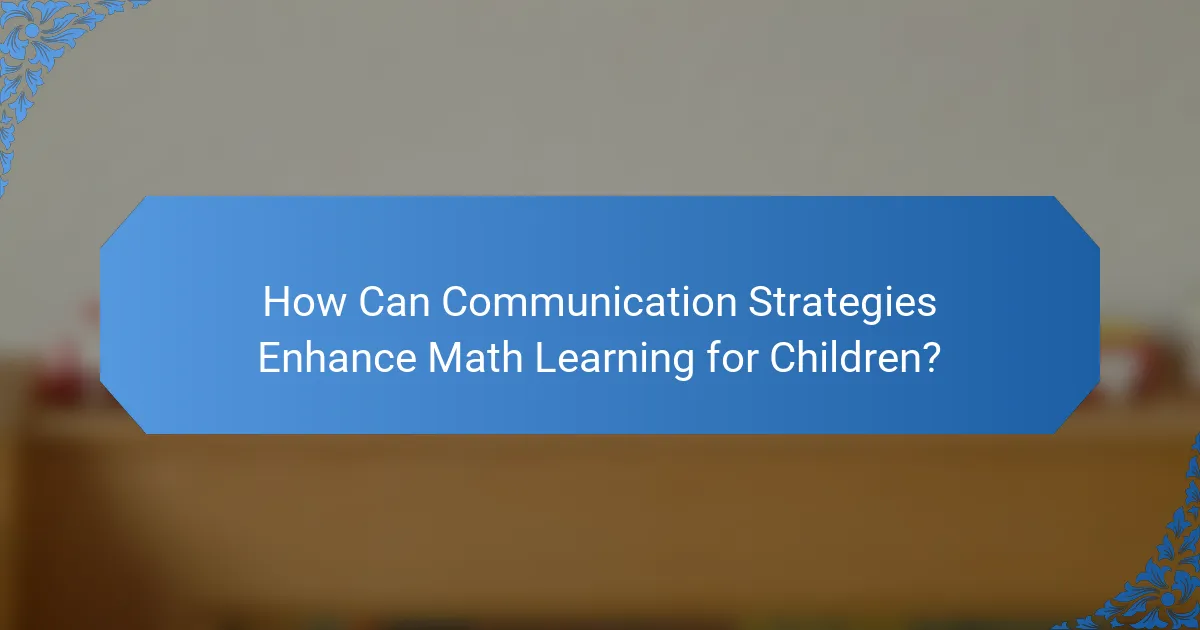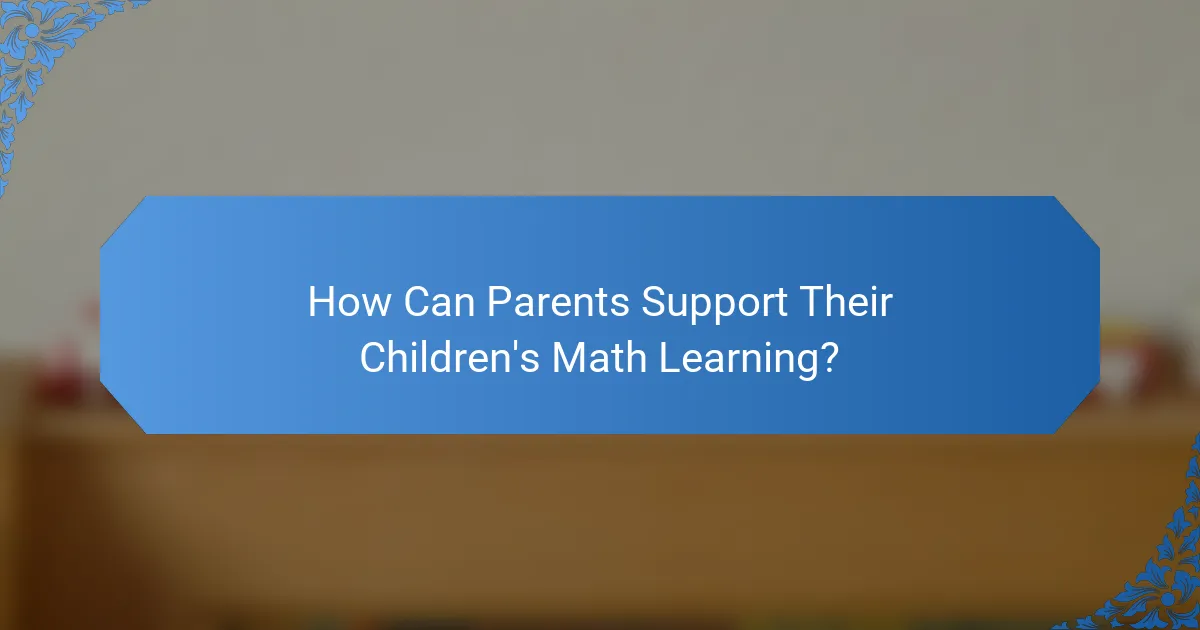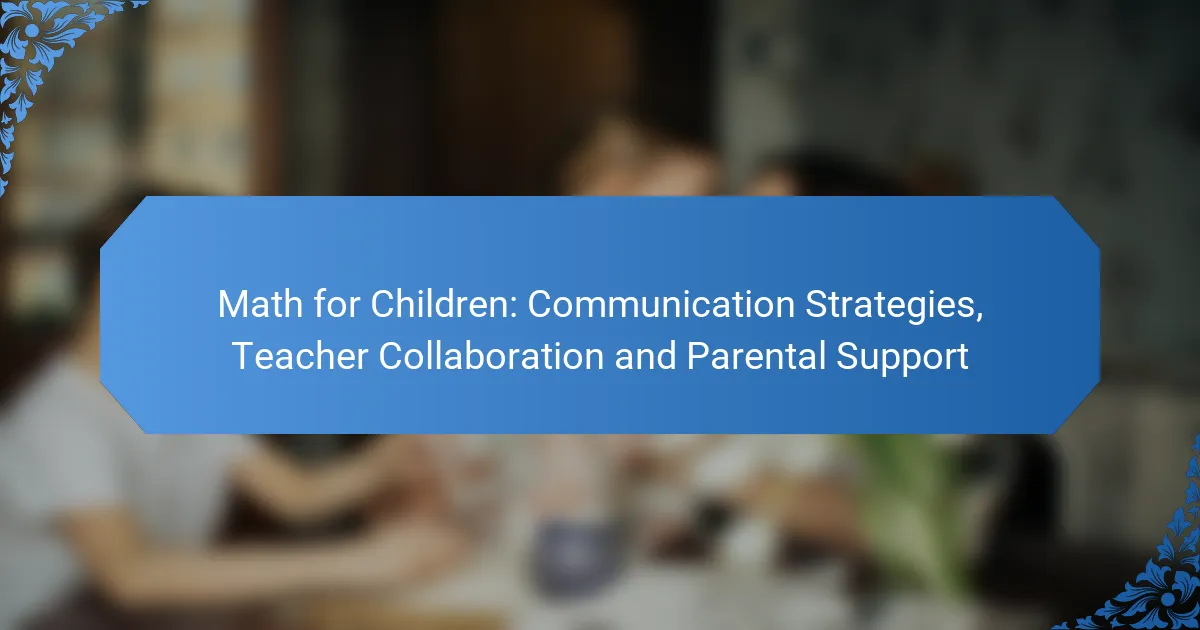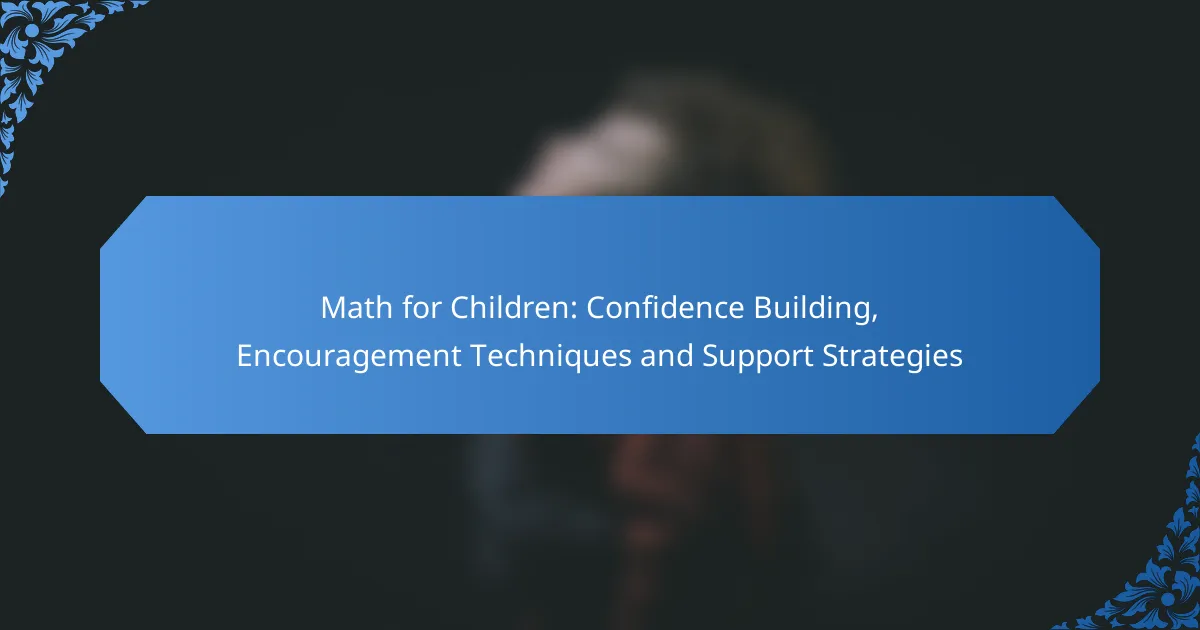Effective communication strategies among teachers, parents, and students play a crucial role in enhancing children’s understanding of math concepts. By fostering collaboration and support, educators can share valuable insights and resources, while parents can create enriching environments that promote a positive attitude toward math learning.

How Can Communication Strategies Enhance Math Learning for Children?
Effective communication strategies can significantly improve children’s understanding of math concepts. By fostering clear dialogue between teachers, parents, and students, these strategies create a supportive learning environment that encourages exploration and mastery of mathematical skills.
Use of Visual Aids
Visual aids, such as charts, diagrams, and manipulatives, can help children grasp abstract math concepts more easily. For instance, using blocks to represent numbers allows students to visualize addition and subtraction. Incorporating colorful visuals can also capture children’s attention and enhance retention.
When selecting visual aids, consider the age and learning style of the child. Younger students may benefit from hands-on materials, while older children might prefer graphs or digital tools. Aim to integrate these aids into lessons regularly to reinforce learning.
Interactive Discussions
Interactive discussions encourage students to engage actively with math topics. By asking open-ended questions and prompting students to explain their thought processes, teachers can deepen understanding and promote critical thinking. This dialogue can take place in small groups or one-on-one settings.
To facilitate these discussions, create a safe space where students feel comfortable sharing their ideas. Use prompts that relate to real-life situations, such as budgeting or measuring, to make math relevant and relatable.
Encouraging Questions
Encouraging questions fosters a curious mindset in children, which is essential for effective math learning. Teachers should invite students to ask questions about concepts they find challenging and provide thoughtful responses that guide them toward solutions.
To promote this habit, model questioning techniques yourself. For example, ask students what they think about a particular problem before providing an answer. This approach not only validates their thoughts but also encourages them to think critically about math.
Feedback Mechanisms
Implementing feedback mechanisms is crucial for tracking student progress in math. Regular feedback helps children understand their strengths and areas for improvement, allowing them to adjust their learning strategies accordingly. This can be done through quizzes, peer reviews, or informal assessments.
Ensure that feedback is constructive and specific. Instead of simply stating what was wrong, provide guidance on how to approach similar problems in the future. This helps students develop resilience and a growth mindset.
Storytelling Techniques
Using storytelling techniques can make math more engaging and relatable for children. By framing math problems within a narrative context, students can better understand the relevance of math in everyday life. For example, telling a story about a character who needs to solve a math problem to achieve a goal can spark interest.
Incorporate stories that reflect diverse cultures and experiences to resonate with all students. This approach not only enhances math learning but also promotes inclusivity and empathy among peers.

What Role Does Teacher Collaboration Play in Math Education?
Teacher collaboration is essential in math education as it fosters a supportive environment where educators can share insights, strategies, and resources to enhance student learning. By working together, teachers can address diverse student needs and improve instructional practices.
Shared Resources and Strategies
Collaborative teaching allows educators to pool their resources, creating a rich repository of materials that can be utilized across classrooms. This can include lesson plans, worksheets, and digital tools that cater to various learning styles. For instance, a group of teachers might develop a shared online platform to access and contribute math resources.
Additionally, sharing effective teaching strategies can lead to improved student engagement and understanding. Teachers can experiment with different approaches, such as hands-on activities or technology integration, and share the outcomes with their peers.
Professional Development Opportunities
Collaboration among teachers often leads to enhanced professional development opportunities. Educators can organize workshops or training sessions focused on innovative math teaching methods, ensuring that all participants benefit from collective expertise. This can be particularly effective when addressing new curriculum standards or educational technologies.
Moreover, participating in joint professional development can foster a sense of community among teachers, encouraging ongoing support and collaboration beyond formal training sessions.
Co-Teaching Models
Co-teaching models, where two or more teachers work together in the same classroom, can significantly enhance math instruction. This approach allows for differentiated instruction, enabling teachers to address varying student abilities simultaneously. For example, one teacher might focus on direct instruction while the other provides targeted support to struggling students.
Implementing co-teaching requires clear communication and planning between educators to ensure that both teachers are aligned in their goals and methods. Regular feedback sessions can help refine the co-teaching approach and improve student outcomes.
Regular Planning Meetings
Establishing regular planning meetings is crucial for effective teacher collaboration in math education. These meetings provide a structured time for educators to discuss curriculum alignment, share student progress, and strategize on instructional practices. A consistent schedule, such as weekly or bi-weekly meetings, can help maintain momentum and focus.
During these meetings, teachers can analyze student data to identify trends and adjust their teaching strategies accordingly. This data-driven approach ensures that instruction is responsive to student needs, ultimately enhancing learning outcomes in math.

How Can Parents Support Their Children’s Math Learning?
Parents can significantly enhance their children’s math learning by creating supportive environments, engaging in math activities, maintaining communication with teachers, and utilizing online resources. These strategies foster a positive attitude toward math and help children develop essential skills.
Creating a Math-Friendly Home Environment
Establishing a math-friendly home involves integrating math into everyday life. This can be achieved by labeling household items with their quantities, using measuring cups while cooking, or discussing shapes and patterns in the environment.
Designate a specific area for homework and math-related activities, ensuring it is well-lit and free from distractions. A consistent routine can also help children feel more comfortable and focused during their math practice.
Engaging in Math Activities
Participating in math activities can make learning enjoyable. Simple games like board games that involve counting or strategy can reinforce math concepts while providing fun bonding time.
Consider using everyday situations to practice math, such as budgeting for groceries or calculating discounts during shopping. This real-world application helps children see the relevance of math in their daily lives.
Communicating with Teachers
Regular communication with teachers is crucial for understanding a child’s progress in math. Parents should attend parent-teacher conferences and ask for feedback on their child’s strengths and areas for improvement.
Establishing a relationship with the teacher can also provide insights into effective strategies that can be implemented at home. Don’t hesitate to ask for resources or recommendations tailored to your child’s needs.
Utilizing Online Resources
There are numerous online resources available that can support children’s math learning. Websites and apps often offer interactive games and exercises that cater to various skill levels, making learning engaging and accessible.
Parents should explore platforms that align with their child’s curriculum, ensuring that the content is relevant and beneficial. Many resources are free or available at a low cost, making them an affordable option for enhancing math skills.

What Are Effective Math Teaching Methods for Young Learners?
Effective math teaching methods for young learners focus on engaging students through interactive and relatable experiences. These approaches foster a deeper understanding of mathematical concepts and encourage a positive attitude towards learning math.
Hands-On Learning Approaches
Hands-on learning approaches involve using physical objects to teach math concepts, making abstract ideas more tangible. For example, using blocks or counters can help children grasp addition and subtraction by visually and physically manipulating the items.
To implement hands-on learning, teachers can create activities that allow students to explore math through real-life scenarios, such as measuring ingredients for a recipe or counting items during a shopping trip. This method not only enhances understanding but also makes math relevant to everyday life.
Incorporating Technology
Incorporating technology into math education can enhance engagement and provide personalized learning experiences. Interactive apps and online games can adapt to a child’s skill level, offering tailored challenges that keep them motivated.
When using technology, it’s essential to choose age-appropriate tools that align with learning objectives. For instance, platforms like Khan Academy or Prodigy Math provide resources that can supplement classroom instruction and allow for practice at home.
Game-Based Learning
Game-based learning uses the principles of gaming to teach math concepts, making learning fun and competitive. This approach can include board games, card games, or digital games that require strategic thinking and problem-solving.
To effectively implement game-based learning, educators should select games that reinforce specific math skills, such as multiplication or geometry. Setting clear learning goals and providing feedback during gameplay can enhance the educational value while keeping students engaged.

What Criteria Should Be Considered for Selecting Math Programs?
When selecting math programs, it’s essential to consider alignment with curriculum standards, inclusivity and accessibility, and evidence of effectiveness. These criteria ensure that the program meets educational goals and supports diverse learners.
Alignment with Curriculum Standards
Choosing a math program that aligns with local curriculum standards is crucial for ensuring that students meet educational benchmarks. Look for programs that explicitly reference state or national standards, such as the Common Core in the United States or the National Curriculum in the UK.
Check if the program covers key mathematical concepts and skills appropriate for the grade level. For example, a program for elementary students should focus on foundational skills like addition, subtraction, and basic geometry.
Inclusivity and Accessibility
An effective math program should be inclusive and accessible to all students, including those with learning disabilities or language barriers. Programs that offer differentiated instruction, visual aids, and multilingual resources can help meet diverse needs.
Consider whether the program provides various ways for students to engage with the material. For instance, interactive online platforms or hands-on manipulatives can cater to different learning styles and enhance understanding.
Evidence of Effectiveness
Look for math programs that have demonstrated effectiveness through research or case studies. Programs backed by empirical evidence often show improved student outcomes and engagement. Check for testimonials from educators and data on student performance.
Additionally, consider programs that offer ongoing assessment tools to track student progress. Regular assessments can provide insights into areas needing improvement and help tailor instruction to individual student needs.



